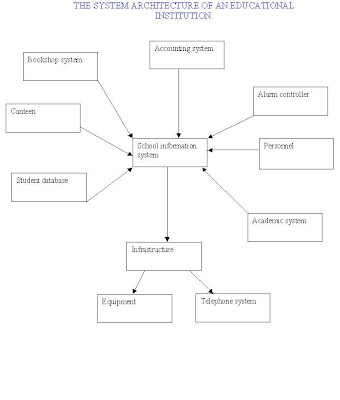Definition of the following terms:
Definition of system software
http://en.wikipedia.org.system
According to our view system software can be that the system software is a general term referring to any computer software which manages and controls the hardware so that the application software(software that performs a specific task or function, such as word-processing or creation of spread sheet)can perform any task.
Examples
we think that examples could be the operating system of any computer and also the windows system and the desktop .
Definition of real-time software
http://wikipedia.org/wiki/Real-time computing
I understand that Real-time systems are ones where a correct computation depends not only on obtaining the right result, but also obtaining the right result within a given time constraint. The real-time software are often addressed in the context of real-time operating systems.
Examples
1.The real-time constraint in the system is the short time in which the brakes must be applied to prevent the wheel from locking.The real time deadline be met redardless of the system load.
2.A chess playing program designed to play in a tournament with a clock will need to decide on a move before a certain deadline or lose the game.
3.Robot that has to pick up something from a conveyorbelt. The piece is moving, and the robot has a small window to pick up the object. If the robot is late, the piece won't be there anymore, and thus the job will have been done incorrectly, even though the robot went to the right place. If the robot is "early", the piece won't be there yet, and the robot may block it.
4.Another example is the servo loops in an airplane when on auto-pilot.The sensors of the plane must continuously supply the control computer with proper measurements. If a measurement is missed, the performance of the airplane can degrade, sometimes to unacceptable levels.
Definition of business software
http://en.wikipedia.org/wiki/business_software
Business software is generally any software program that helps a business increase productivity or measure their productivity. The term covers a large variation of uses within the business environment, and can be classified by using a small, medium and large matrix:
Examples
The small business market generally consists of home accounting software, and office suites such as Microsoft Office and OpenOffice.org.
The medium size, or SME, has a broader range of software applications, ranging from accounting, groupware, customer relationship management, human resources software, loan origination software, shopping cart software, field service software, and other productivity enhancing applications. The last segment covers enterprise level software applications, such as those in the fields of enterprise resource planning, enterprise content management (ECM), business process management and product lifecycle management. These applications are extensive in scope, and often come with modules that either add native functions, or incorporate the functionality of third-party software programs.
Definition of scientific software
http://www.answers.com
http://en.wikipedia.org/wiki/Software
Scientific and engineering software satisfies the needs of a scientific or engineering user to perform enterprise-specific tasks. Because scientific and engineering tasks tend to be very enterprise-specific, there has been no generalization of this application area analogous to the that of the ERP for backoffice business systems. The scientific-engineering application usually is considered to be in second place only to business software in terms of software products built.
Examples
1.a software used in laboratories for data analysis of "objects" which needs to be experimented .
SoilVision Lite is a module of the SoilVision software which will add database functionality and professional quality reporting to your soils laboratory. Manage both particle size (grainsize) sieve data or hydrometer data. Professional reports including particle size distributions on a variety of formats may be produced.Automatic classification of your soil, automatic calculation of standard variables, mathematical representation of sieve analysis data and professional laboratory report generation provides your company with the most advanced database system currently available for geotechnical, geoenvironmental, or soil science data.
Embedded systems
http://en.wikipedia.org/wiki/Embedded_system
According to us an embedded system is a special-purpose computer system designed to perform one or a few dedicated functions . It is usually embedded as part of a complete device including hardware and mechanical parts. In contrast, a general-purpose computer, such as a personal computer, can do many different tasks depending on programming. Since the embedded system is dedicated to specific tasks, design engineers can optimize it, reducing the size and cost of the product, or increasing the reliability and performance..
Artificial intelligence
http://en.wikipedia.org/wiki/Artificial_intelligence
The modern definition of artificial intelligence (or AI) is "the study and design of intelligent agents" where an intelligent agent is a system that perceives its environment and takes actions which maximizes its chances of success. John McCarthy, who coined the term in 1956, defines it as "the science and engineering of making intelligent machines. Other names for the field have been proposed, such as computational intelligence, synthetic intelligence or computational rationality. The term artificial intelligence is also used to describe a property of machines or programs: the intelligence that the system demonstrates.
AI research uses tools and insights from many fields, including computer science, psychology, philosophy, neuroscience, cognitive science, linguistics, operations research, economics, control theory, probability, optimization and logic. AI research also overlaps with tasks such as robotics, control systems, scheduling, data mining, logistics, speech recognition, facial recognition and many others.
Web applications
http://en.wikipedia.org/wiki/Web_application
A web application framework is a software framework that is designed to support the development of dynamic websites, Web applications and Web services. The framework aims to alleviate the overhead associated with common activities used in Web development. For example, many frameworks provide libraries for database access, templating frameworks and session management, and often promote code reuse.

